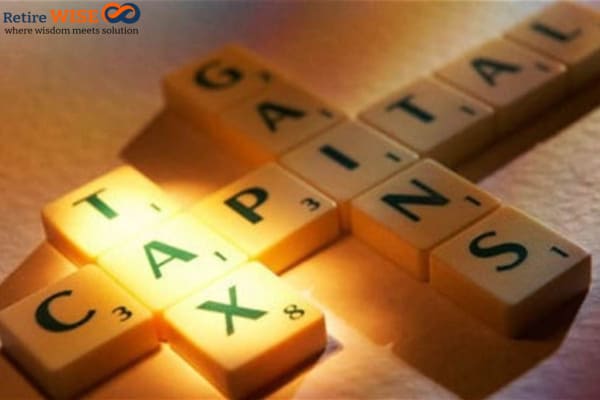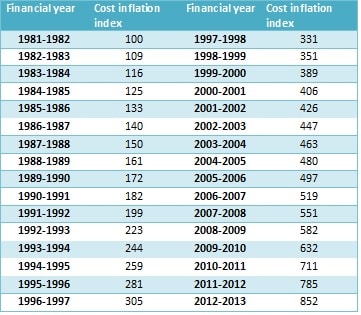If I mention a string of numbers like 939, 852, 785, 711, can you guess what these are? Well, this is not a question that you get in numerical ability question of any recruitment exam, but these numbers have potency to save a lot of money particularly if you are investing in Mutual Funds or Real Estate. And to answer the question- these numbers are value of Cost Inflation Index (CII) from year 2013-14 to year 2010-11. As the term suggest it refers to the cost of asset, which faces inflation. Let’s try to understand the concept and application in detail.

Cost Inflation Index – The Concept
There are 2 terms to calculate gain on any investment. One is the simple (nominal) return and second is called the real returns. The difference between the two is inflation. For eg a house purchased in 2005 for Rs 4 Cr in Mumbai and sold for 5 Cr in 2013 the gain is Rs 1Cr. Or simply:
Nominal Gain = Selling Price of Asset – Purchase Price of Asset
But is the concept right? Was Rs 4 Cr in 2005 a smaller amount? It is not equivalent to Rs 4 Cr of present times as the value of money has eroded due to country’s inflation. So would it be right by the Income Tax department to charge tax on entire gain? Instead they should be charging the tax on Real Return, which are returns minus the inflation.
Real Gain = Selling Price of Asset – Inflation Adjusted Purchase Price of Asset
So how do you calculate the Inflation Adjusted Purchase Price? If let on investor, each person will have his own view in inflation, hence the CBDT (Central Board of Direct Taxes) comes out with a unique number, which is used for calculating indexed cost. For the year 2013-14 the number is 939 vis a vis 852 for year 2012-13. This means CBDT thinks that in this year inflation eroded value of assets by 10.2% ((939-852)/852 multiply by 100). The table below shows the indexation figures for 1981 when the base was taken as 100.

Cost Inflation Index (CII) 2013-14 939
Hence CBDT standardizes the calculation for purchases price of an investment. They started giving this number for year 1982-83. For all purchases before 1981, the factor used is the base factor which is 100. (but if its real estate you have to bring some documents which provides rates of property in that area in 1980 – registries that were done in that period)
CII – The Implication
In case of long term capital gains an investor can reduce his tax payment by using the indexation benefit. The rules are a bit different for real estate and securities:
1) For investments in Property: The Long Term Capital Gain (LTCG) is calculated when property is sold after 3 years otherwise it is a Short Term Capital Gain.
Tax payment= 20% of gains after taking indexed purchase cost
(It is mandatory to take the indexed cost as purchase price)
2) For investments in Securities: The Long Term Capital Gain (LTCG) is calculated when investments is sold after 1 years otherwise it is a Short Term Capital Gain.
Without Indexation Tax Payment = 10% of Gain
With Indexation Tax payment= 20% of gains after taking indexed purchase cost
Calculation for above example:
Indexed purchase price = Purchase cost multiply Index Factor
Indexed purchase price = (4 Cr * Index Factor of 2013)/Index Factor of 2005-06
Indexed purchase price= (4 Cr * 939)/497
Indexed purchase price= 7.56 Cr
Since purchase price is more than the Selling price, the investor is making a loss hence no tax is payable.
Read – Mutual Fund Taxation in India
Applicability
The cost inflation index can be used for calculating long term capital gains (LTCG) for investments in securities and real estate. Since LTCG is nil for investments in Equities, hence it has no relevance for calculating LTCG for investments in shares and equity mutual funds. But it is useful to calculate LTCG in debt oriented mutual funds (especially Bond funds and Fixed Maturity Plans).
Ground rule:
- In case of Debt Mutual Funds LTCG can be claimed only if the holding period is more than 1 year.
- In case of property LTCG can only be claimed if the holding period is more than 3 years. (However DTC has suggested to reduce property holding time to 1 year.)
It cannot be used to:
- Calculate STCG in case of property if sold in less than 3 years of holding period.
- Calculate LTCG on equity investments as they are tax free as per current rules.
I have mentioned an example above showing how this is used in property transaction. Let me show you how this can be used in debt funds. The concept is widely used in FMPs from mutual funds. This is the reason you see plethora of FMP issues of 13 months or 25 months in March month. The idea is to get a double indexation or triple indexation benefit. So if a 13 month FMP allotment date is on 21 March 2012 and maturing on 22 April 2013, it passes through two 1 April dates hence it can claim a double indexation benefit and will use indexation figure of 2011-12 and 2013-14 for calculating the LTCG. (this may go away after DTC)
So if one invests Rs 7.5 Lakhs in a 367 day FMP in March 2012, and gets maturity in April 2013 the working under Double Indexation Benefit will be as mentioned below. Also a comparison with the fixed deposit of similar tenure has been tabulated:
|
Calculation with Indexation Benefit |
||
|
FMP |
Fixed Deposit |
|
| Amount of Investment |
7,50,000 |
7,50,000 |
| Annualised Yield |
10.35% |
10.35% |
| Tenure |
367 Days |
367 Days |
| Maturity Amount |
8,28,077 |
8,28,077 |
| Gain |
78,077 |
78,077 |
| Indexed Cost |
8,26,585 |
NA |
| Indexation Gain/Loss |
(76585.00) |
NA |
| Income Tax |
Nil |
Gain will be added to income. |
So indexation can be used to save a good amount of tax payment especially if a person comes in higher tax brackets. This is the reason Fixed Maturity Plans (FMPs) and bond funds have seen a rise in issue and subscription. This benefit can and should be taken by investing towards the end of a financial year, if the investor has surplus funds, because the capital gains virtually becomes tax free due to the double indexation benefit. A major number of investors are unaware about this benefit.
Read – Fixed Deposits Vs Fixed Maturity Plan (FMP)

You may feel that I have put lot of numbers in this post, but this is a simple concept which must be brought into light so that investors can take benefit from taxation. I am not saying that you have to memorize the calculation. Just learn the concept and the CII figure and calculators are available online or through your financial planner.
Hope you enjoyed learning this concept. Do share if you have used this concept and benefited. Waiting for your comments.
Dear Sir,
This is very useful information for us request you to elaborate more with some more examples.
Regards,
Hi Dishant,
What is the specific example you are looking at?
Cost Inflation Index where will we find this for previous year and future years,
how to use this for example
If i sell my property i receive money directly.
when i show capital gain means i need to show this calculation too.
Out of somany articles i found this one most interesting and eye opener
thanks
Mohan
Hi Mohan,
The gains on your property are calculated using Cost Inflation Index. By using CII you indexed your cost of purchase and then calculate the capital gains. For this a simple formula is used
Indexed Cost= Cost of purchase * CII of Year Property is Sold/ CII of Year Property is bought
You will show capital gains calculated by using this formula.
Great information Hemant. I wasn’t aware of it, longer tenure FMPs seems to be a better option than FDs.
Thanks for educating!
Hello Hemanth, Thanks for sharing the great information. It is good lerning for me. I am bit confused on the index numebrs, however the concept was clear to me. I will also look into invsting in FMPs than looking only for FDs.
Thanks
Viswamohan
Dear sir, what an enlightening text. Never thought about it. thank you.
This is very useful article.
i HAVE Invest in the FMP 366 days….on dated 30th August 2013 & my maturity date is 31st August 2014…….
Would i get the benefit of double indexation or single indexation ???
Hi Sumaya,
With two financial years you will get the benefit of double indexation but this rule may changed in DTC where the investment date rather than financial years will be taken for capital gains calculation.
The topic dealt is very informative. Thanksss…
Sir,
What about SIP in mutual funds which include a mixture of investments -certain percentage in debt funds and others in equities? How are these taxed? Are they tax free?
Susheel
Hi Susheel,
Gains from equity mutual funds are tax free but gains form debt mutual funds are taxable.
Dear Sir,
I read your posts regularly. You are great in explaining topics regarding financial planning in very simple way which is very easy to understand.
Thanks a lot.
With regard
Thanks Aman.
Why indexation benefit is not given to Bank FDs.
Hi Hemant,
In case I have indexed captial gain of Rs. 10000 then over it I have to pay 20% tax i.e. Rs. 2000.
1. Will this tax be deducted at source i.e. TDS by mutual fund house? TDS certificate will be issued?
2. While filling ITR do I need to show this indexed captial gain of Rs. 10000 as an Income from capital gain?
2.1 In such case for salaried person, the total tax will be levied on sum of Income from Salary and Income from capital gain?
2.2 As long as I am in 20% or 30% bracket I may have to pay additional tax. What if I am in 10% bracket? Will that excess amount be refunded?
3. In case I have capital gain under both calculations i.e. under indexation and without indexation. And its obvious that capital gain under indexation will always be lesser than without-indexation. How can an investor opt for which calculation he can consider? Is there any procedure of following particular capital gain taxing?
Great Post written by you.
Comments are closed.